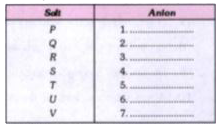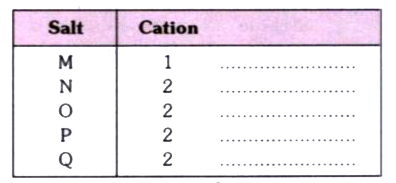[A] : Gibberellic acid , when added to isolated aleurone , induce amylase activity
[R] : The enzyme amylase converts insoluble starch into soluble sugars
If both A and R are true and R is the correct explanation of A
If both A and R are true but R is not the correct explanation of A
If A is true and R is false
If both A and R are false
The correct Answer is:B
Step by step video & image solution for [A] : Gibberellic acid , when added to isolated aleurone , induce amylase activity [R] : The enzyme amylase converts insoluble starch into soluble sugars by Biology experts to help you in doubts & scoring excellent marks in Class 12 exams.
Topper's Solved these Questions
Similar Questions
[A]: Gibberellic acid when added to isolated aleurone layer, induces alfa-amylase activity. It acts at gene level.
[R]: GA may act at the gene level or just activates the inactive enzyme or interact to re- move enzyme inhibitor.View SolutionAssertion : Gibberellic acid increases the yield of malt from barley grain.
Reason :Gibberellins stimulate the synthesis of amylase, protease and other hydrolytic enzyme for mobilisation of reserve food.View SolutionOne of the effects of Gibberellins is to induce the synthesis of amylase enzyme which causes the break down of starch and provides nourishment to the embryo in the seed. This phenomenon leads to the germination of seed. The hormone antagonist to this phenomenon is
View SolutionWhen you take cells or tissue pieces and grind them with an acid in a mortar and pestle, all the small biomolecules dissolve in the acid. Proteins, polysaccharides and nucleic acids are insoluble in mineral acid and get precipitated. The acid soluble compounds include amino acids, nucleosides, small sugars etc. When one adds a phosphate group to a nucleoside one gets another acid soluble biomolecule called
View SolutionA set of 6 test tube having same temperature but different pH were setup to conduct an experiment . To each of the tubes, starch and amylase were added in a mix of sterile water . The concentration was kept the same . The following table notes the reaction completion time for each of the six tubes.
PH1357911Time taken to complete in seconds (s).94643253566
Using the above data , determine the pH where amylase has shown highest rate of activity.View Solution[A]: High pH in guard cells activate phosphorylase to convert starch into glucose 1-PO4 .
[R]: Stomata open when pH is lowView SolutionFor analysis of a living tissue sample, we first grind it in trichloroacetic acid (Cl3C.COOH) using a mortar and a pestle and obtain a thick slurry. Then, after straining the slurry through a cheese cloth, we obtain two fractions, viz, one is filtrate (or acid-soluble pool) and the other retentate (or acid-insoluble fraction). We observed that all the small biomolecules are present in the filtrate. Whereas, proteins, polysaccharides and nucleic acid get precipitated. The acid soluble compounds include amino acids, nucleosides, small sugars, etc. When one adds a phosphate group to a nucleoside one gets another acid soluble biomolecule. Could you guess its name?
View SolutionIdentify the cation (positive ion) and anion (negative ion) in - 'A','B' & 'C'. Also identify P, Q, R, S, T, U, V, W.
a] Substance 'A' is water soluble and gives a curdy white precipitate 'P' with silver nitrate solution. 'P' is soluble in ammonium hydroxide but insoluble in dil. HNO3 . Substance 'A' reacts with ammonium hydroxide solution to give a white precipitate ' soluble in excess of NH4OH.
b] A solution of substance 'B' is added to barium chloride solution. A white ppt. 'R' is formed, insoluble in dil. HCl or HNO3 . A dirty green ppt. 'S' is formed on addition of ammonium hydroxide to a solution of 'B' and the precipitate is insoluble in excess of ammonium hydroxide.
c] Substance 'C' is a coloured, crystalline salt which on heating decomposes leaving a black residue 'T'. On addition of copper turnings and conc. H2SO4 to 'C' a coloured acidic gas 'U' is evolved on heating. A solution of'C' is added to NaOH soln. until in excess. A pale blue ppt. 'P' is obtained insoluble in excess of NaOH A solution of 'C' is then added to NH4OH soln. in excess to give an inky blue solution 'V'. A solution of 'C' is warmed and hydrogen sulphide gas is passed through it. A black ppt. 'W' appears.View SolutionSalts P, Q,R,S,T,U and V undergo reactions (i) to (vii) respectively. Identify the cation present in these salts on the basis of these reactions. Tabulate your answer in the formate given below.
(i) When the salt Pis heated with sodium hydroxide solution a vigorous reaction takes place and a colourless gas is evolved with a pungent and suffocating smell that brings tears in our eyes. The evolved gas gives dense white fumes with a moist glass rod depped with hydrochloric acid.
(ii) Addition of sodium hydroxide solution to a solution of salt Q gives a thick white precipitae which is soluble in excess of sodium hydroxide solution to form a clear solution.
(iii) Addition of ammonium hydroxide solution to a solution of salt R gives a dark blue precipitate which is soluble is excess of ammonium hydroxide solution to form an intense deep blue solution.
(iv) Addition of ammonium hydroxide solution to a solution of 5 gives a dirty green [bottle green] precipitate which is insoluble even in the excess of ammonium hydroxide solution.
(v) Addition of ammonium hydroxide solution to a solution of T gives a reddish brown (rust precipitate] precipitate which is insoluble even in the excess of ammonium hydroxide solution.
(vi) Addition of ammonium hydroxide solution to a solution of V gives a geletaneous white precipitate which is soluble in excess of ammonium hydroxide solution to form a clear solution.
(vii) Addition of ammonium hydroxide solution to a solution of V gives no precipitate but it gives a chalky white precipitate with sodium hydroxide solution which is insoluble even in the excess of sodium hydroxide solution.
 View Solution
View SolutionSalts M, N, O, P and Q undergo reactiom (i) to (v) respectively.
Identify the cation present in these salts on the basis of these reaction. Tabulate your answer in the format given below.
1. When sodium hydroxide solution is added to the salt M, and heated strongly a colourless gas with a pungent smell is evolved which turm red litmus paper blue and gives dense white fumes with a moist glass rod with hydrochloric acid.
2. Addition of dilute hydrochloric acid to a solution of N gives a thick white precipitate which is soluble in hot water.
3. When ammonium hydroxide solution is added to the solution of 0 a light blue precipitate is obtained which is soluble in excess of ammonium hydroxide to form an inteme deep blue solution.
4. When ammonium hydroxide solution is added to the solution of P reddish brown (mustard colour) precipitate is obtained which ,is insoluble even in the excess of ammonium hydroxide solution.
5. When sodium hydroxide solution is added to the solution of Q a which coloured gelatinous precipitate is obtained which is soluble in excess of sodium hydroxide to form a clear solution
 View Solution
View Solution

